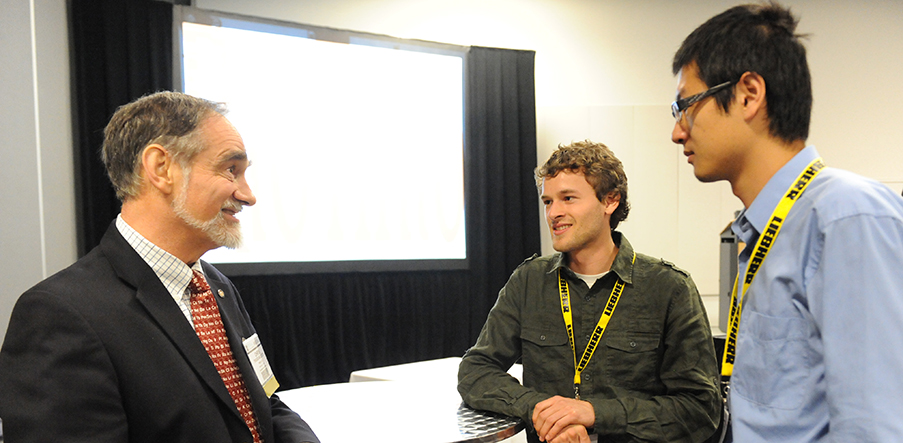Elle Crosby - 18 December 2017
Chris Twigge-Molecey with some students at the CIM Convention
The design and construction process of a plant, in particular a metallurgical plant, always has risks. The book, Metallurgical Plant Design, is the consolidated effort of several engineers to provide essential instruction on how to mitigate these risks and ultimately, increase the success of the plant.
Chris Twigge-Molecey is a mechanical and metallurgical engineer who has worked with Hatch for over 40 years and been a member of CIM since 1991. He moved to Canada from the UK to study at the University of Toronto, and after completing his PhD in fluid mechanics, he stayed for the job opportunities and for the girl he fell in love with. Twigge-Molecey is one of the main authors of Metallurgical Plant Design, which he explains is essential reading for anyone involved in the process of operating or designing a metallurgical plant.
CIM: What made you come up with the idea for the book?
Twigge-Molecey: I’d been publishing for about ten years on why [metallurgical plant] projects have failed – where failure is huge budget overruns, slow ramp-ups and other significant consequences to the owners – and eventually I realized that instead of explaining why past projects failed, the only way to do something about it was to lay out how to do the engineering function so that projects would stay on track in the future. There are a huge number of books on project and construction management and an infinite number of books on engineering principles, but there was nothing on engineering management. How do you manage the actual engineering aspect once you’ve done the arithmetic so that you can efficiently build a plant without all the disruptions? That’s what we wanted to answer.
CIM: Who should read the book?
Twigge-Molecey: There are certainly lots of different kinds of people who can benefit from reading the book – financiers, design engineers, process engineers, researchers – but the key target audience was project managers and owners who don’t understand the consequences of decisions that sometimes seem arbitrary to the rest of the design process.
CIM: While yourself, Rob Boom, Frank Wheeler and Jack Young took the lead, there were a total of 17 authors for this book from different countries, companies, schools, and specialties – how did this group of authors come together?
Twigge-Molecey: The book idea was evolved by myself with Frank Wheeler. We sat down and sketched out what the thing might look like and we worked with Angela Hamlyn and Jean Vavrek to get the support of CIM. We looked at the table of contents and thought of who we knew who would be really competent in dealing with each of the topics without paying any particular attention to where they were or who they worked for. To do something like this takes a huge personal commitment, so we did approach some people who would have liked to help but weren’t able to. Quite a large percentage of the authors were from Hatch and that was because I suppose I was in a position at the time to personally persuade them to do it! But we had lots of Australians and people from all over. We’d have teleconferences around certain topics at key times. It definitely helped that many of the authors were at least semi-retired.
CIM: Did any problems arise throughout the process of writing the book?
Twigge-Molecey: We had one of those moments when you realize you’ve missed something very important – there was no overarching framework for what we were writing about, and that was risk management, so we had to insert a new chapter on risk management and then go back through each chapter and make sure it tied back to that theme. It’s not just physical risk but risk of project success.
CIM: What was the most memorable moment in the creation of MPD?
Twigge-Molecey: The whole process was very rewarding, just from the willingness from our disparate group of people to work together and produce something they believed in, particularly among a group of people who have mostly never met one another to this day. In terms of memorable moments, actually holding the printed book in my hands. That was a moment I won’t forget.
 - dev.png)


